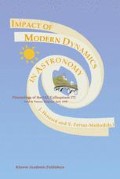Abstract
Range of values of the Sun’s mass quadrupole moment of coefficient J 2 arising both from experimental and theoretical determinations enlarge across literature on two orders of magnitude, from around 10−7 until to 10−5. The accurate knowledge of the Moon’s physical librations, for which the Lunar Laser Ranging data reach an outstanding precision level, prove to be appropriate to reduce the interval of J 2 values by giving an upper bound of J 2. A solar quadrupole moment as high as 1.1 10−5 given either from the upper bounds of the error bars of the observations, or from the Roche’s theory, is not compatible with the knowledge of the lunar librations accurately modeled and observed with the LLR experiment. The suitable values of J 2 have to be smaller than 3.0 10−6.
As a consequence, this upper bound of 3.0 10−6 is accepted to study the impact of the Sun’s quadrupole moment of mass on the dynamics of the Earth-Moon system. Such an effect (with J 2 = 5.5 ± 1.3 × 10−6) has been already tested in 1983 by Campbell & Moffat using analytical approximate equations, and thus for the orbits of Mercury, Venus, the Earth and Icarus. The approximate equations are no longer sufficient compared with present observational data and exact equations are required. As if to compute the effect on the lunar librations, we have used our BJV relativistic model of solar system integration including the spin-orbit coupled motion of the Moon. The model is solved by numerical integration. The BJV model stems from general relativity by using the DSX formalism for purposes of celestial mechanics when it is about to deal with a system of n extended, weakly self-gravitating, rotating and deformable bodies in mutual interactions.
The resulting effects on the orbital elements of the Earth have been computed and plotted over 160 and 1600 years. The impact of the quadrupole moment of the Sun on the Earth’s orbital motion is mainly characterized by variations of ̇Ω, ̇ω, and ̇Ė. As a consequence, the Sun’s quadrupole moment of mass could play a sensible role over long time periods of integration of solar system models.
Access this chapter
Tax calculation will be finalised at checkout
Purchases are for personal use only
Preview
Unable to display preview. Download preview PDF.
Abbreviations
- LLR:
-
Lunar Laser Ranging
- GR:
-
general relativity
- PN:
-
post-Newtonian
- mas:
-
milliarcsecond
References
Bois, E., Boudin, F., Journet, A.: 1996, ‘Secular Variation of the Moon’s Rotation Rate’, A&A 314, pp. 989–994.
Bois, E., Journet, A.: 1993, ‘Lunar and Terrestrial Tidal Effects on the Moon’s Rotational Motion’, Celest. Mech. 57, pp. 295–305.
Bois, E., Vokrouhlický, D.: 1995, ‘Relativistic Spin Effects in the Earth-Moon System’, A&A 300, pp. 559–567.
Bois, E., Wytrzyszczak, I., Journet, A.: 1992, ‘Planetary and Figure-figure Effects on the Moon’s Rotational Motion’, Celest. Mech. 53, pp. 185–201.
Campbell, L., and Moffat, J.W.: 1983, ‘Quadrupole Moment of the Sun and the Planetary Orbits’, The Astrophys. Journal 275, L77–L79
Damour, T., Soffel, M., Xu, Ch.: 1991, 1992, 1993, 1994, ‘General Relativistic Celestial Mechanics’, Phys. Rev. D43, 3273, D45, 1017, D47, 3124, D49, 618.
Dickey, J.O., Bender, P., Faller, J., et al.: 1994, ‘Lunar Laser Ranging: A Continuing Legacy of the Apollo Program’, Science 265, pp. 482–490.
Moons, M.: 1984, ‘Planetary Perturbations on the Libration of the Moon’, Celest. Mech. 34 pp. 263–273.
Müller, J., Schneider, M., Soffel, M., Ruder, H.: 1996, ‘Determination of Relativistic Quantities by analyzing Lunar Laser Ranging Data’, in: Proceedings of the 7th Marcel Grossmann Meeting, eds. R. Jantzen and G. Mac Keiser, 1517.
Pijpers, F.P.: 1998, ‘Helioseismic determination of the solar gravitational quadrupole moment’, Mon. Not R. Astron. Soc. 297, pp. L76–L80
Rozelot, J.-P., and Bois, E.: 1998, ‘New Results Concerning the Solar Oblateness’, Synoptic Solar Physics, ASP Conf. Series 140, pp. 75–82
Williams, J.G., Newhall, X.X., and Dickey, J.O.: 1995, ‘Relativity Parameters Determined from Lunar Laser Ranging’, Phys. Rev. D53, pp. 6730–6739.
Author information
Authors and Affiliations
Editor information
Editors and Affiliations
Rights and permissions
Copyright information
© 1999 Springer Science+Business Media Dordrecht
About this paper
Cite this paper
Bois, E., Girard, J.F. (1999). Impact of the Quadrupole Moment of the Sun on the Dynamics of the Earth-Moon System. In: Henrard, J., Ferraz-Mello, S. (eds) Impact of Modern Dynamics in Astronomy. Springer, Dordrecht. https://doi.org/10.1007/978-94-011-4527-5_33
Download citation
DOI: https://doi.org/10.1007/978-94-011-4527-5_33
Publisher Name: Springer, Dordrecht
Print ISBN: 978-94-010-5930-5
Online ISBN: 978-94-011-4527-5
eBook Packages: Springer Book Archive

